Types of helenium: 16 vibrant varieties for pots and borders
These types of helenium add razzle-dazzle to cottage gardens and prairie plantings – and also attract wildlife to your garden
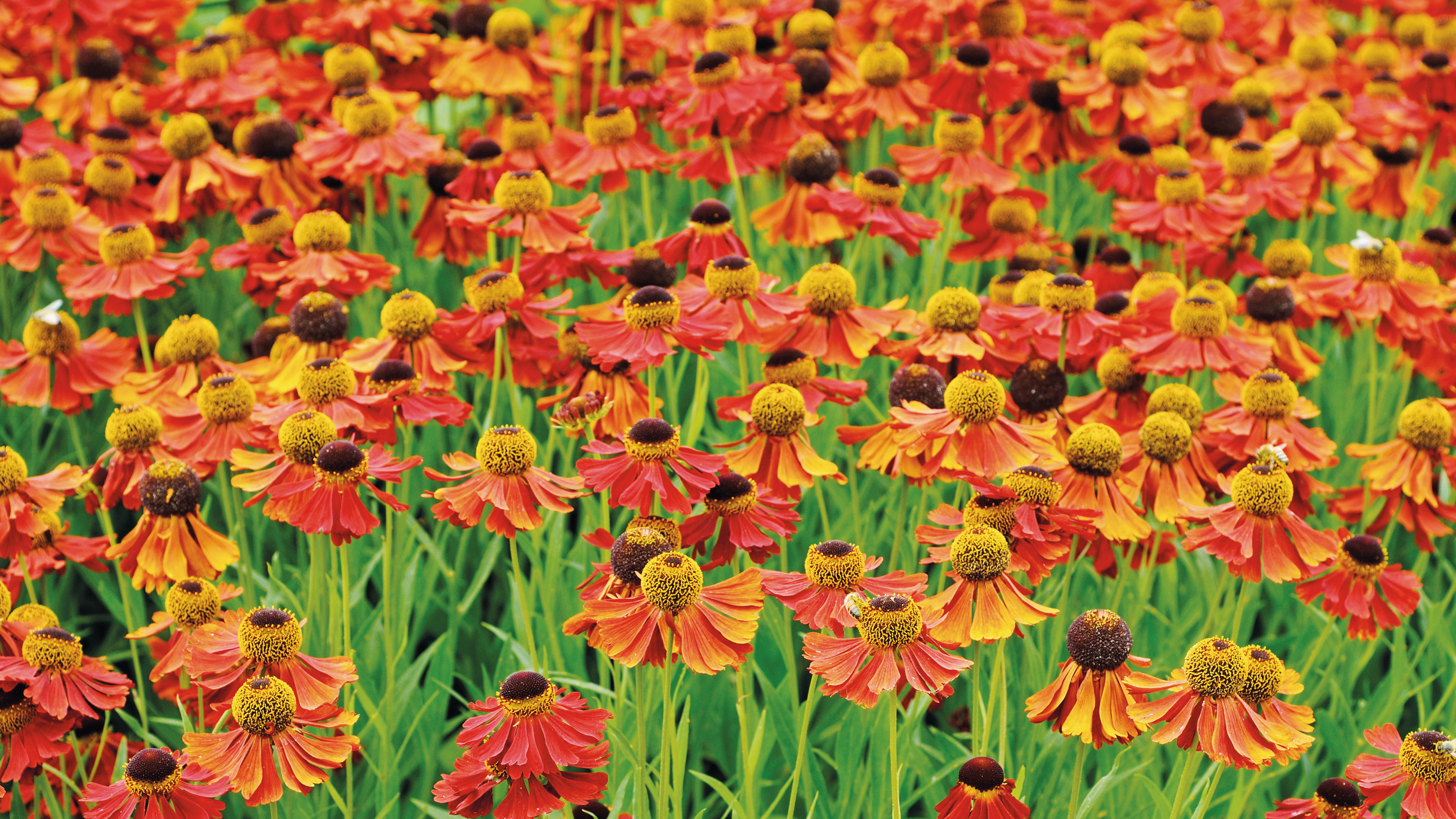

All types of helenium ignite late summer displays with intense, fiery shades. Their stunning daisy-like flowers unfold around a central showy pin-cushion or ‘boss’, each bloom like a vibrant shuttlecock of color. Gold, copper or ruby, these charming late summer beauties inject borders, edgings, prairie plantings and wildlife-friendly flower bed ideas with informal charm.
Flowering from mid summer and as late as mid fall, they provide vital late nectar for bees and butterflies before the cold weather sets in.
The common name for this exhilarating blooms (bafflingly) is sneezeweed. In times gone by, dried helenium was made into a snuff that induced sneezing (and this was deemed to boost health). However, we prefer the romantic German name for helenium: sonnenbraut. This translates to ‘brides of the sun’, a far more poetic description for these striking helenium varieties.
Heleniums (Asteraceae) are sun-worshippers. In their native North America, they thrive in open, sun-baked areas. While flowers with a yellow base tolerate shade for part of the day, red varieties need plenty of sunshine to display the full intensity of their rich palette. Still, as Helenium autumnale heralds from the damper areas of the North American prairies, they prefer well-drained moisture-retentive soils.
Your choice will depend on personal taste and color themes. Sunshine-yellow cultivars like tall, drought-tolerant ‘Tijuana Brass’ are glorious with grasses and add cheer when seasons change. For a mellow gold that blends into a border, ‘Wyndley’ is ideal. If you are more drawn to the medley of fox-red and amber tones, ‘Waltraut’ and ‘Luc’ are popular. However, all 16 helenium varieties are sure to add impact and nectar-rich blooms to late summer displays.
So plant these types of helenium without delay to attract all manner of wildlife to your garden, and fill your pots and borders with a captivating blaze of color.
Try these 16 types of helenium to blaze a trail through your borders
Showy sun-loving helenium varieties range from solid yellows and oranges to deep red and mixed tones. Being late-flowering plants, most types of helenium are bred to create a profusion of blooms over many weeks towards the end of summer as other flowers are starting to die back.
We've rounded up of 16 of the best for garden borders and container growing, from compact pollinators to more statuesque breeds. Placed in full sun and well-draining but moisture-retentive soil, you will find these bold daisy-like medleys of color provide a riot of cheer and interest.
1. ‘Moerheim Beauty’ AGM
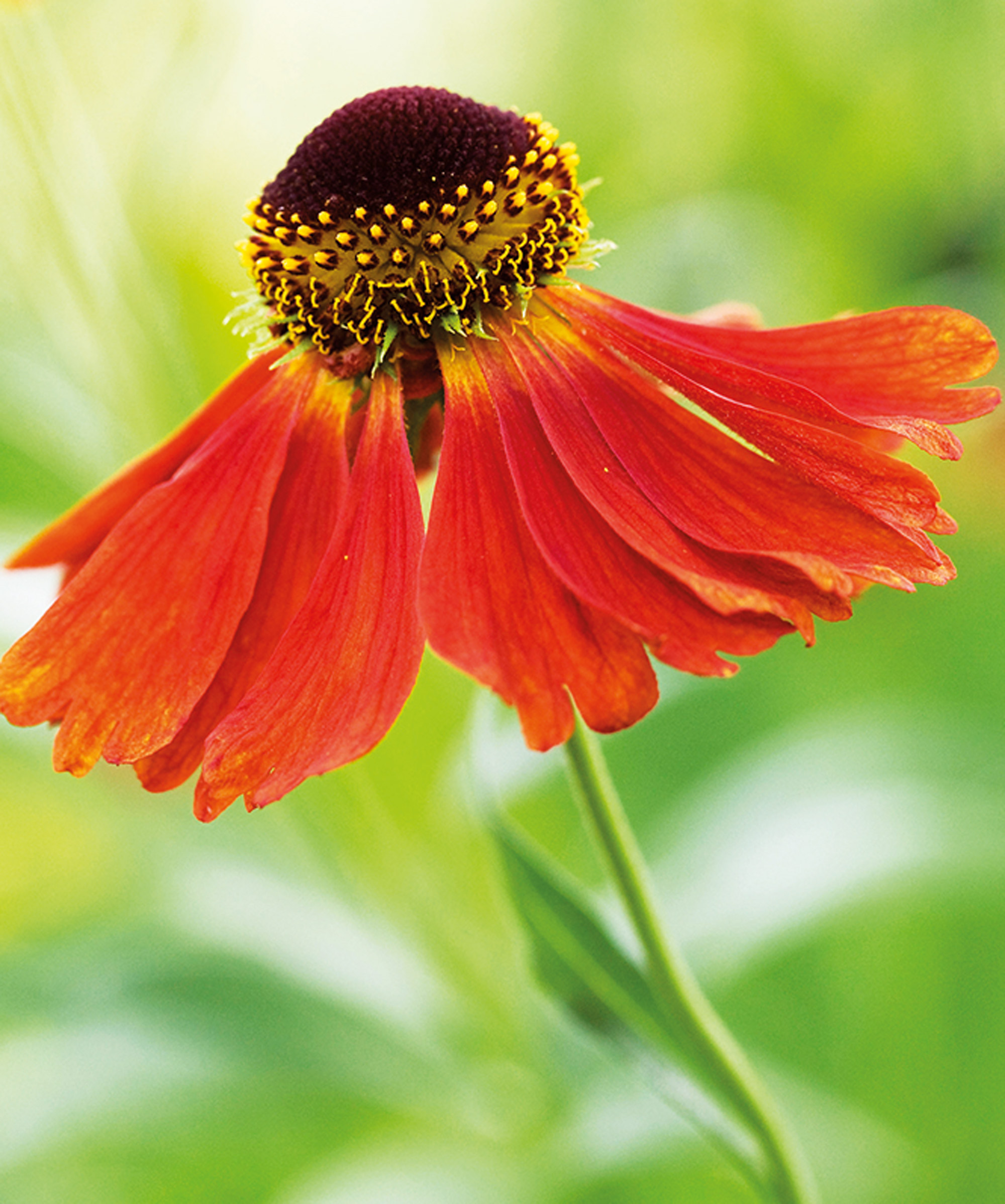
‘Moerheim Beauty’
- Hardiness: USDA 3-8 (UK H7)
- Height: 3-4ft (90-120cm)
- Best for: hot planting schemes
‘Moerheim Beauty’ AGM is one of the old helenium varieties with copper-ruby flowers. It blooms from mid summer to early fall, and the petals take on gold and rust tones as the plants mature. Grow these popular bee-friendly plants in well-drained, moisture-retentive soil in full sun.
As well as working beautifully in orange and red planting schemes with vivid flowers like kniphofia, these are great planting partners for Persicaria amplexicaulis ‘Alba’.
2. ‘Sophie zur Linden’
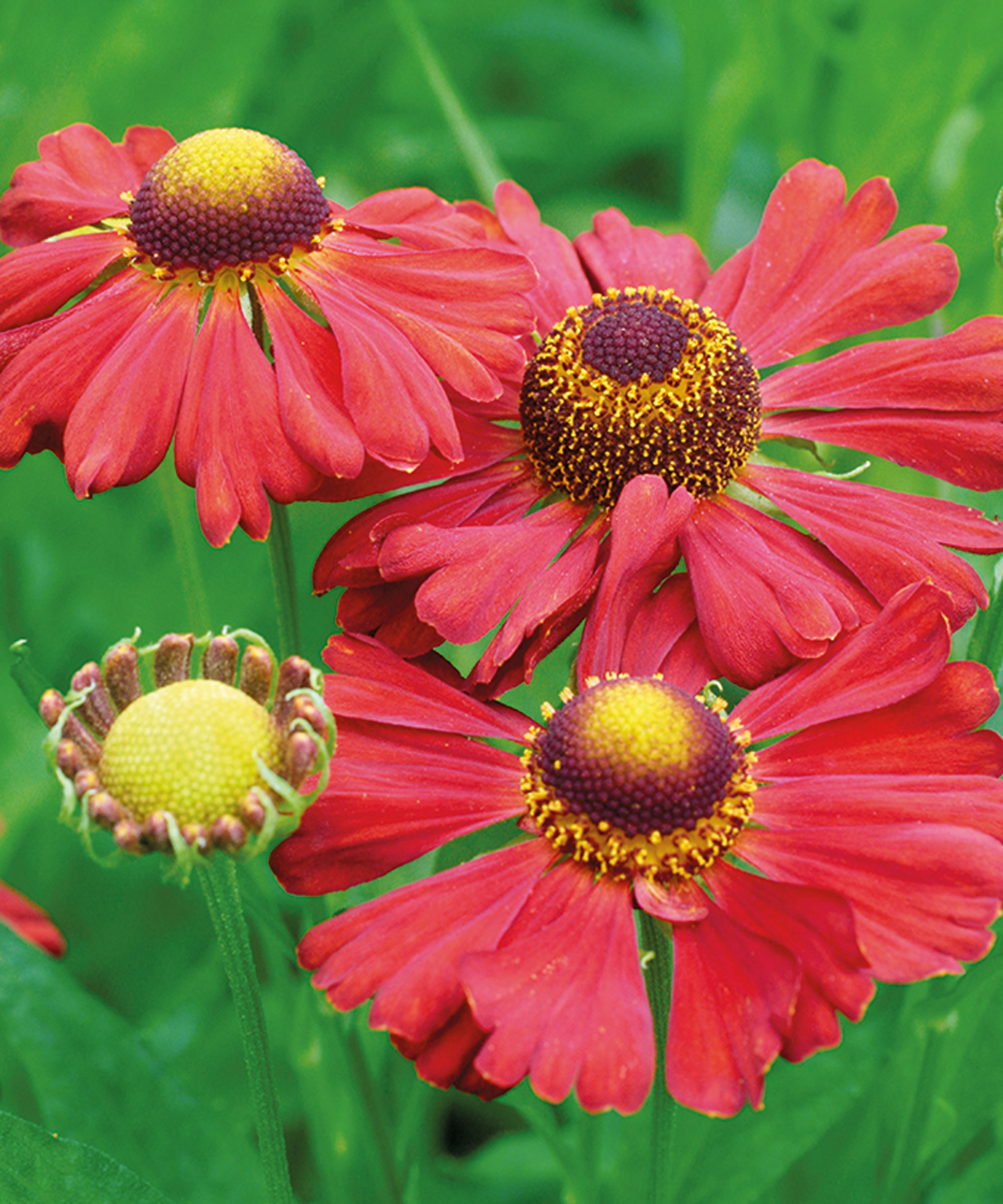
‘Sophie zur Linden’
- Hardiness: USDA 3-8 (UK H7)
- Height: 2-2.5ft (60-75cm)
- Best for: mid-border plantings
Another excellent fiery border blazer, ‘Sophie zur Linden’ is an upright sneezeweed. It produces rich-red and sunset-orange daisies with charcoal brown centers. These blooms bring warmth to the middle of the border, from mid-summer into early fall.
These clump-forming helenium go very well with salvias and rudbeckia. Its vibrant red tones are especially lovely planted in combination with Geranium ‘Rozanne’.
3. ‘Red Army’
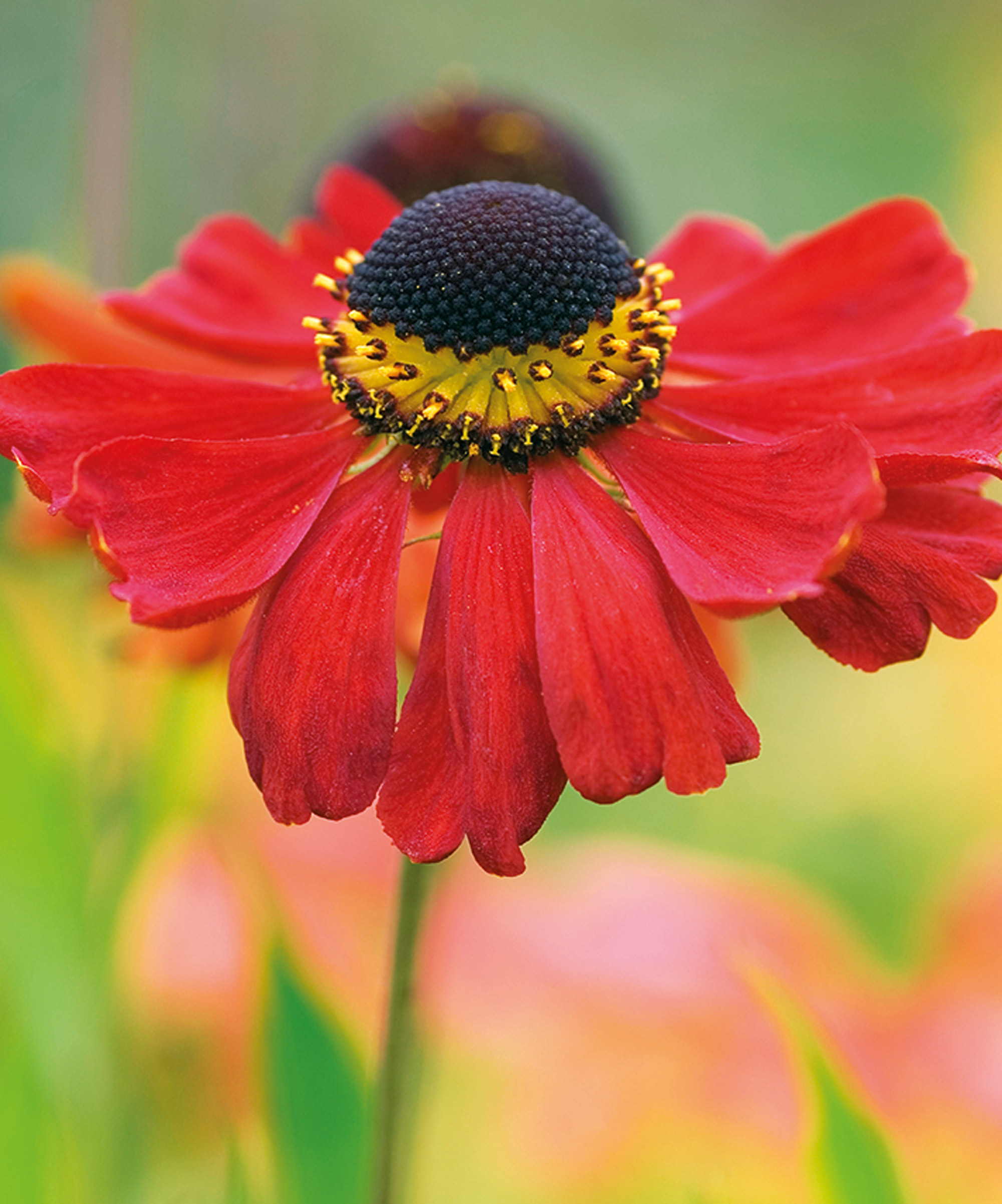
Helenium ‘Red Army’
- Hardiness: USDA 3-8 (UK H7)
- Height: 3-4ft (90-120cm)
- Best for: ornamental grasses
Bees love the rich cherry-red daisies of ‘Red Army’, which blooms between mid summer and early fall. As the flowers of these heleniums mature, they sometimes take on ochre tints and delicate yellow flecks around the petal edges.
These really stand out if planted alongside different types of ornamental grass, and they also make an excellent planting partner for Monarda ‘Scorpion’.
4. ‘Chipperfield Orange’
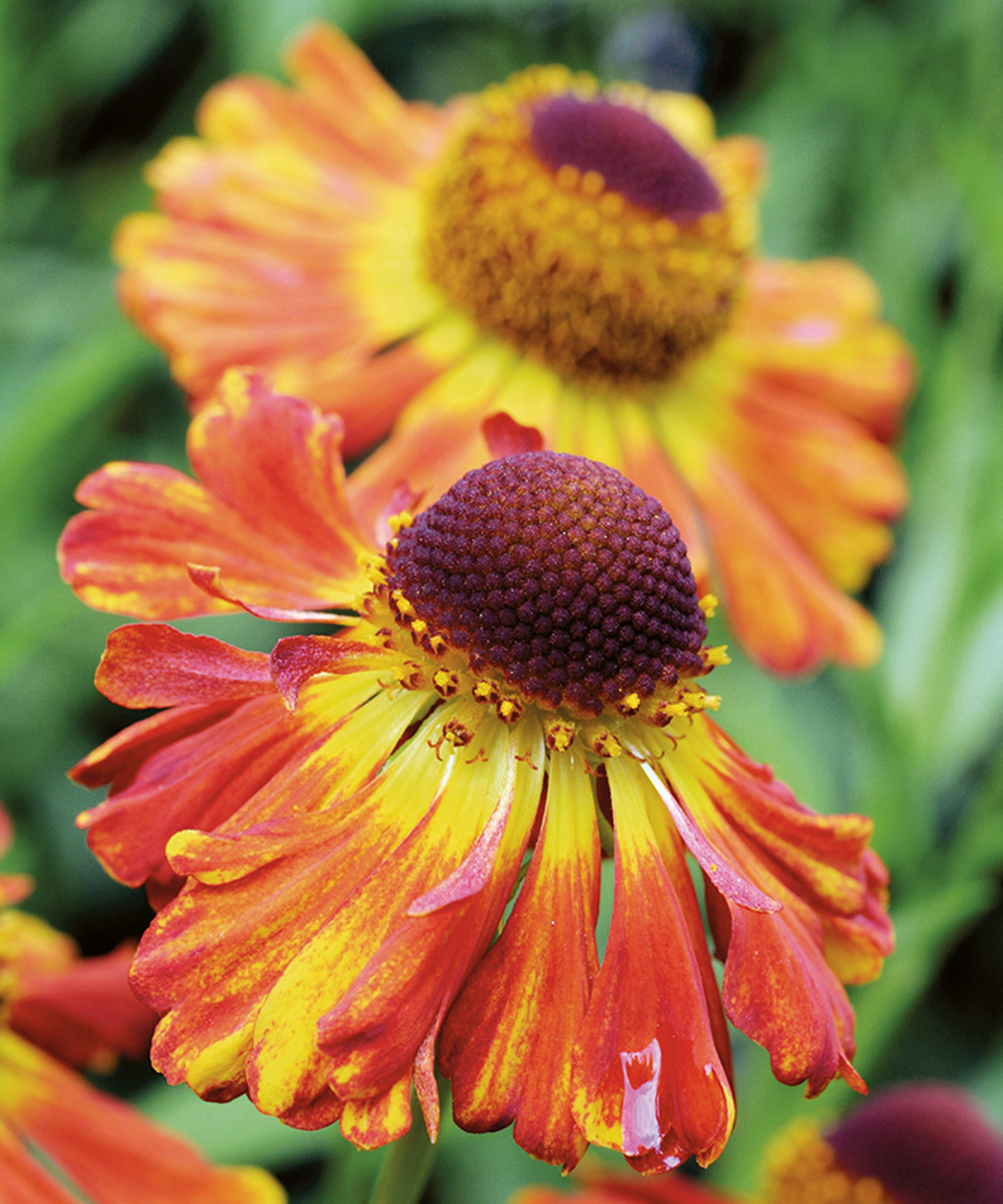
‘Chipperfield Orange’
- Hardiness: USDA 3-8 (UK H7)
- Height: 4-5ft (1.2-1.5m)
- Best for: backs of sunny borders
For those whose tastes run more to coppery orange blooms, ‘Chipperfield Orange’ is an outstanding choice for sunny borders. Growing to 5ft (1.5m), this breed is one of the tallest types of helenium and is especially striking when flanking the edges and backs of sunny garden corners.
Creating a dazzling point of interest as part of creative cottage garden ideas, their terracotta blooms with golden halos around brown cones bloom from late summer to mid fall. Grow with Kniphofia ‘Green Jade’ for ultimate impact.
5. ‘Waltraut’ AGM
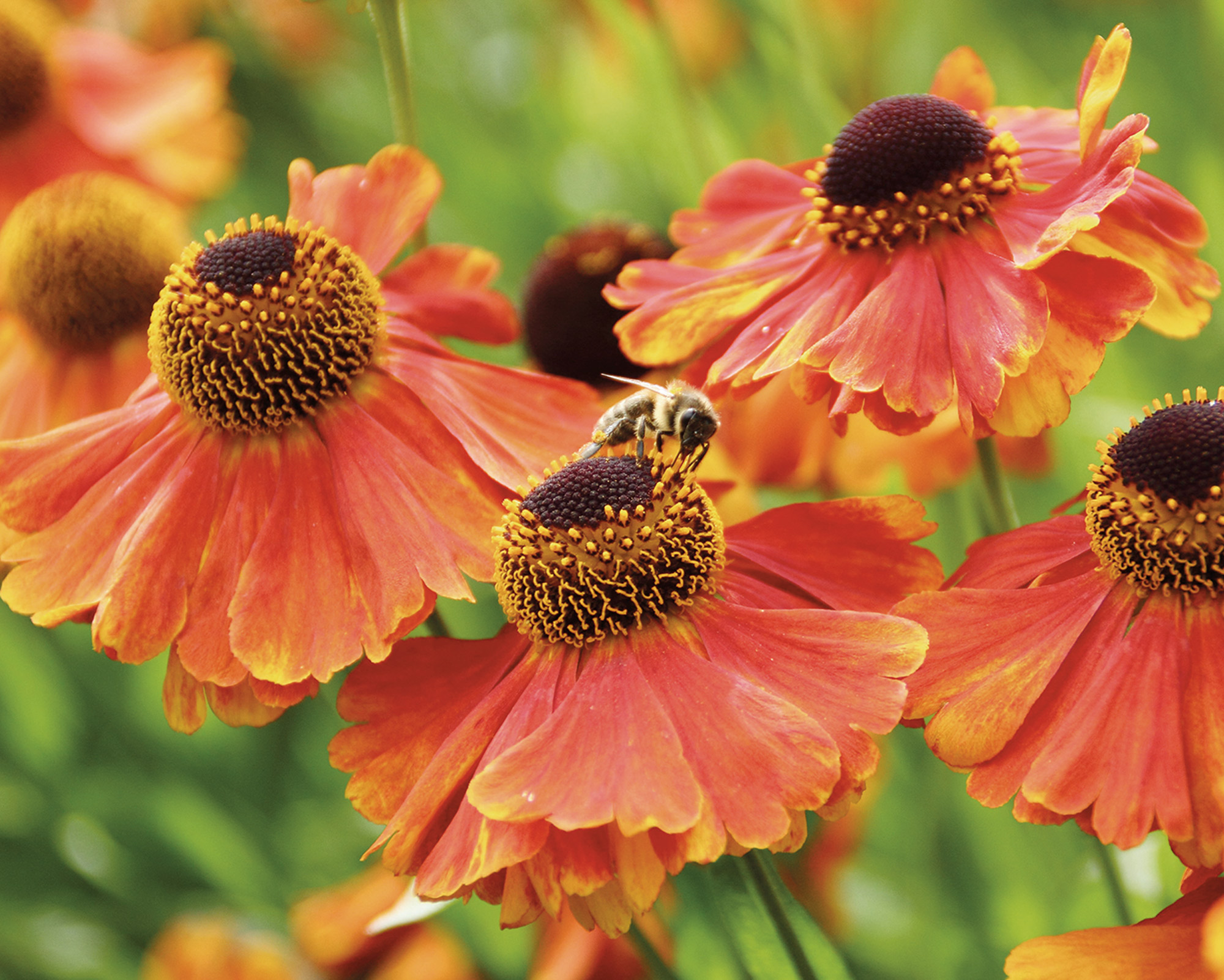
Helenium ‘Waltraut’
- Hardiness: USDA 3-8 (UK H7)
- Height: 2.5-3ft (75-90cm)
- Best for: bold sunny drifts
Stunning rusty orange hues are also guaranteed with ‘Waltraut’ AGM, which flowers freely in late summer and early fall. Their bountiful blooms work well with purple flowers like salvia and verbena, and are particularly striking if grown alongside Crocosmia ‘Hellfire’.
These are amongst the most robust types of helenium you can grow. They form a reliable upright clump of burnt-orange daisies that are tipped deep-yellow around a central protruding brown and gold boss, and flower from mid summer to early fall.
6. ‘Sahin’s Early Flowerer’ AGM
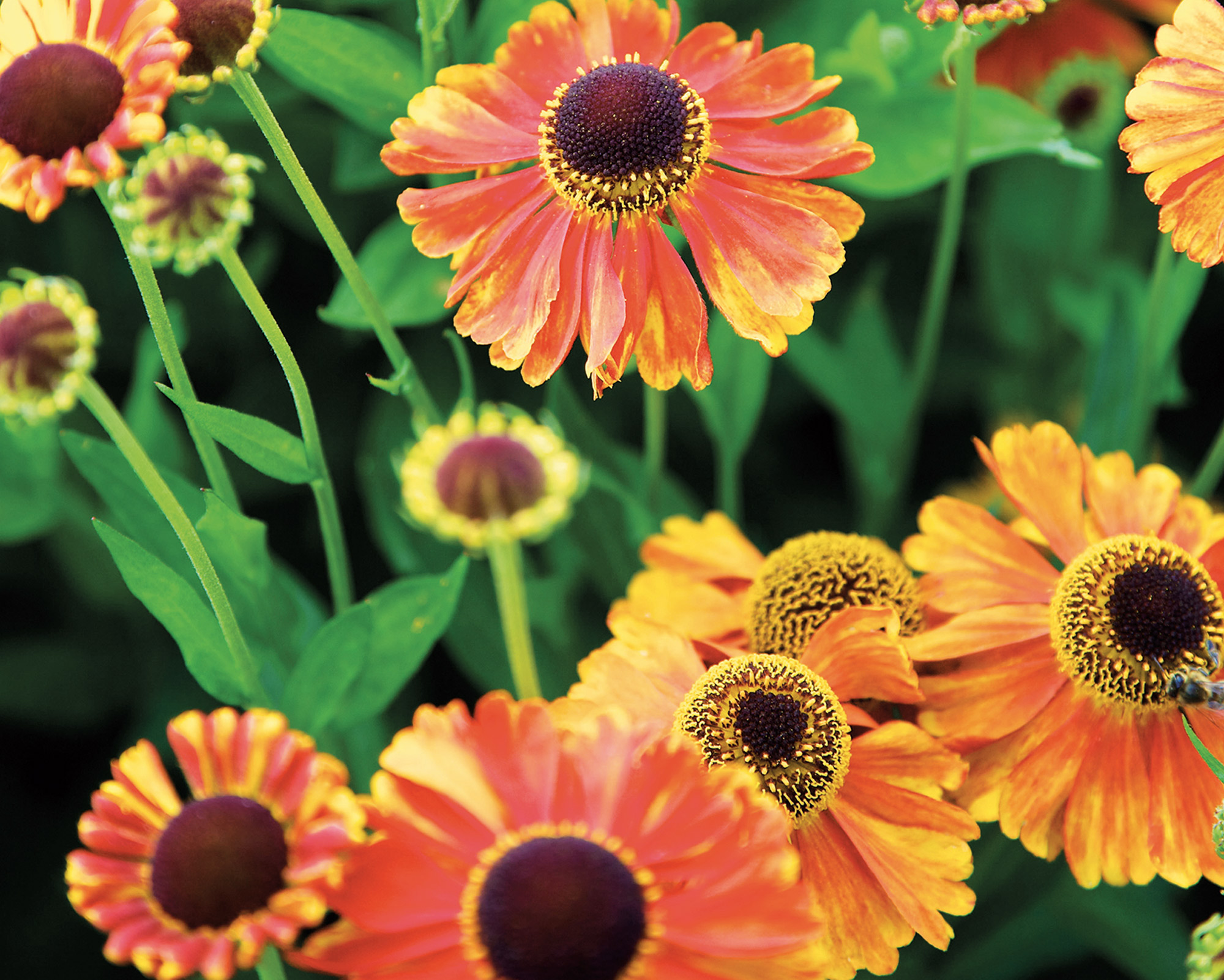
‘Sahin’s Early Flowerer’
- Hardiness: USDA 3-8 (UK H7)
- Height: 2.5-3ft (75-90cm)
- Best for: early flowering orange displays
If you’re keen to get as much mileage out of your zingy orange blooms as possible, choose ‘Sahin’s Early Flowerer’ AGM. With a reputation for being an extensive and prolific bloomer, its long flowering period lasts well into mid fall.
For those looking to grow a butterfly garden, this is one of the most popular options. The ideal planting partner for Agastache 'Blue Fortune’ and blue blooms, it takes on a variety of sunset shades: caramel, gold, and dark-orange.
7. ‘Luc’ AGM
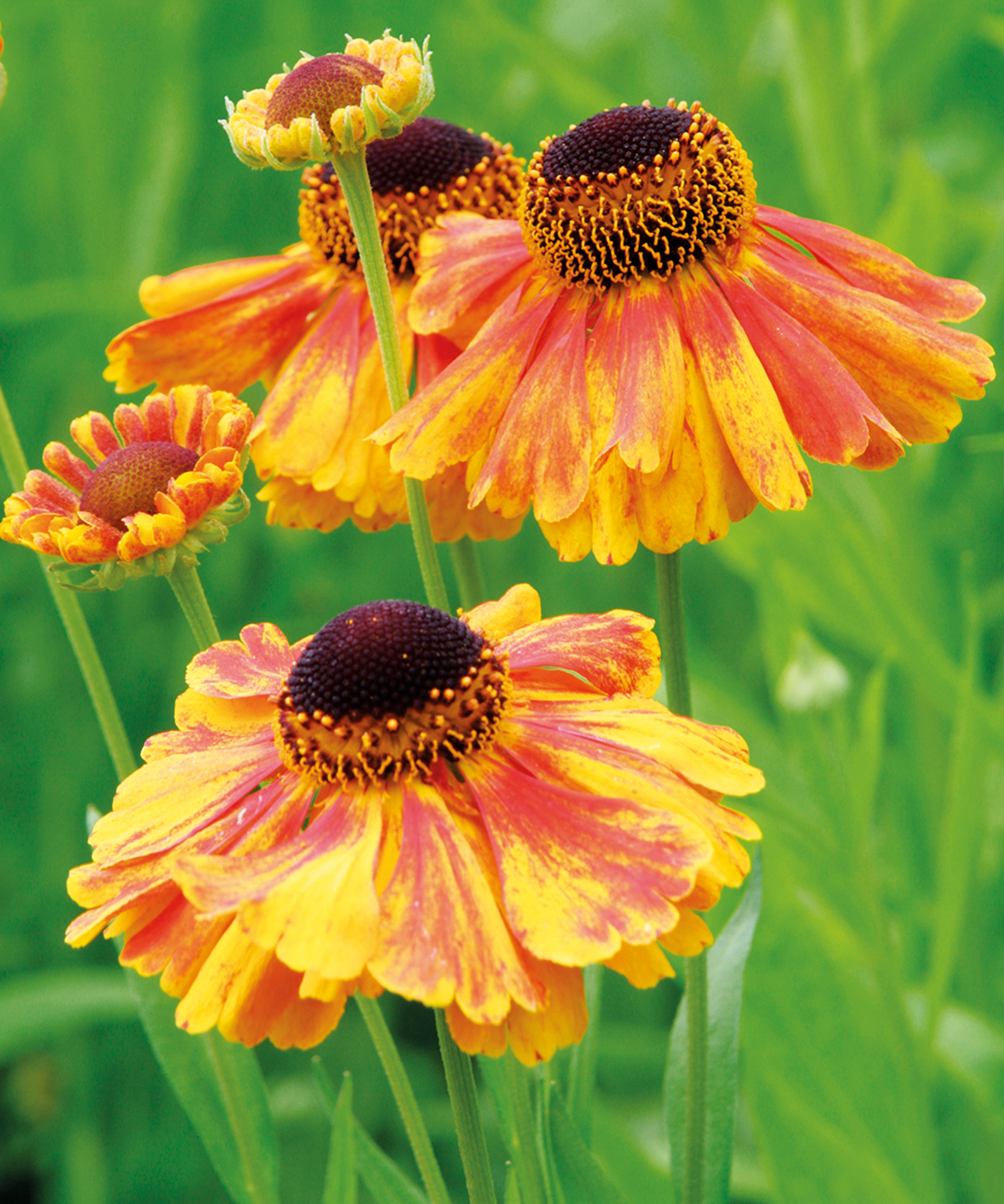
Helenium ‘Luc’
- Hardiness: USDA 3-8 (UK H7)
- Height: 2.5-3ft (75-90cm)
- Best for: mixed prairie planting
‘Luc’ AGM is one of the most highly rated helenium varieties and is arguably even brighter than ‘Sahin’s Early Flowerer’. This excellent multi-toned helenium has large ruby, russet-orange and gold flowers, and blooms from mid summer.
With intriguing changing petal tones, these are lovely in naturalistic plantings with echinacea, hemerocallis and rudbeckia. Plant with Sanguisorba hakusanensis ‘Lilac Squirrel’ for romantic cottage garden contrast.
8. H. autumnale ‘Fuego’
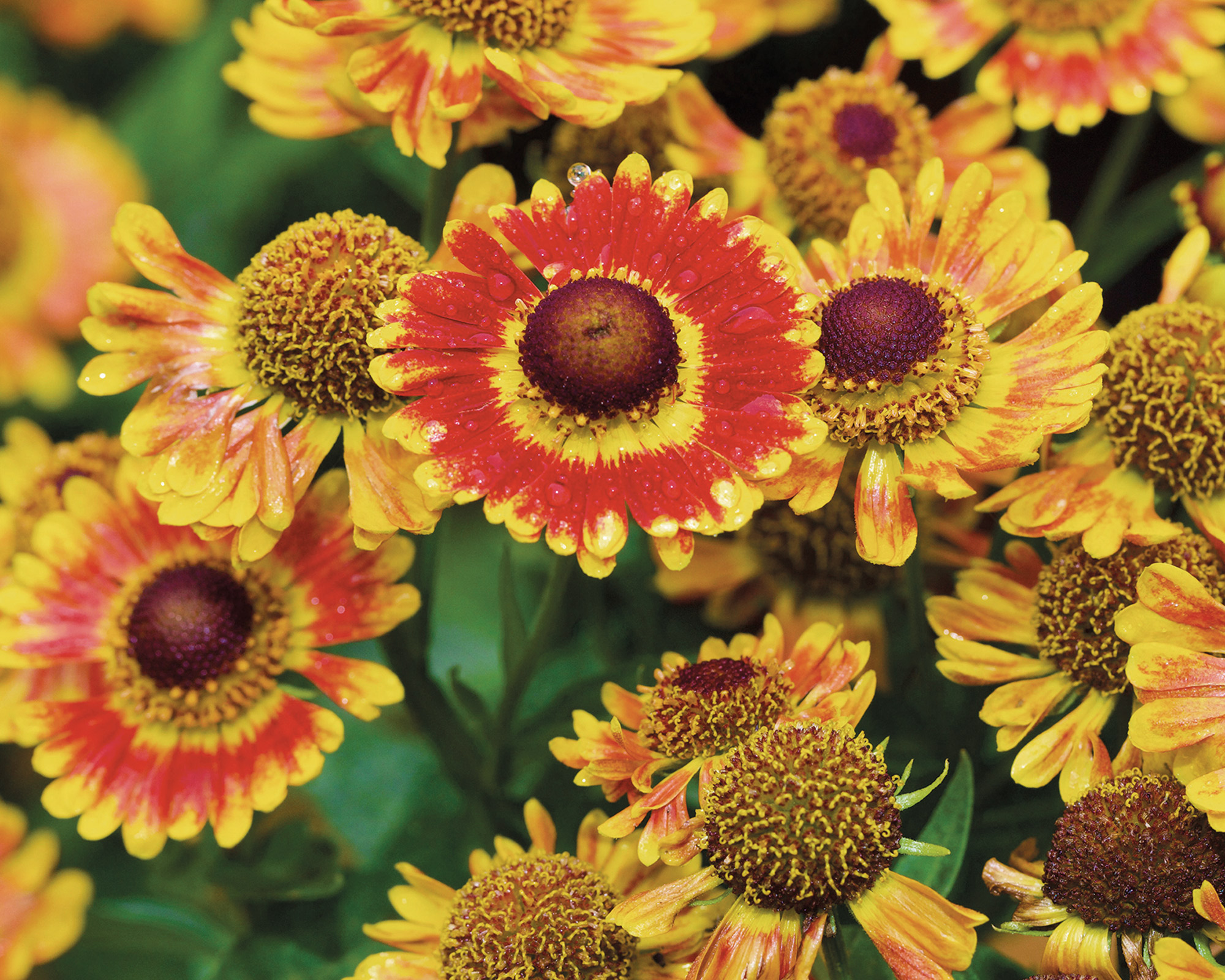
H. autumnale ‘Fuego’
- Hardiness: USDA 3-8 (UK H7)
- Height: 20in (50cm)
- Best for: adventurous color schemes
For a dramatic double whammy of gold and red, look no further than ‘Fuego’. Part of the Mariachi Series, this is a relatively new variety and its blooms create a lively parade of mixed tonal interest from late summer through to mid fall.
If you’re looking for daring garden color schemes, this bushy perennial is the one to try with its compact clumps of bright yellow, rust orange and hot red flowers. For peak shimmering intensity, plant with Briza media ‘Golden Bee’.
9. ‘Rauchtopas’ AGM
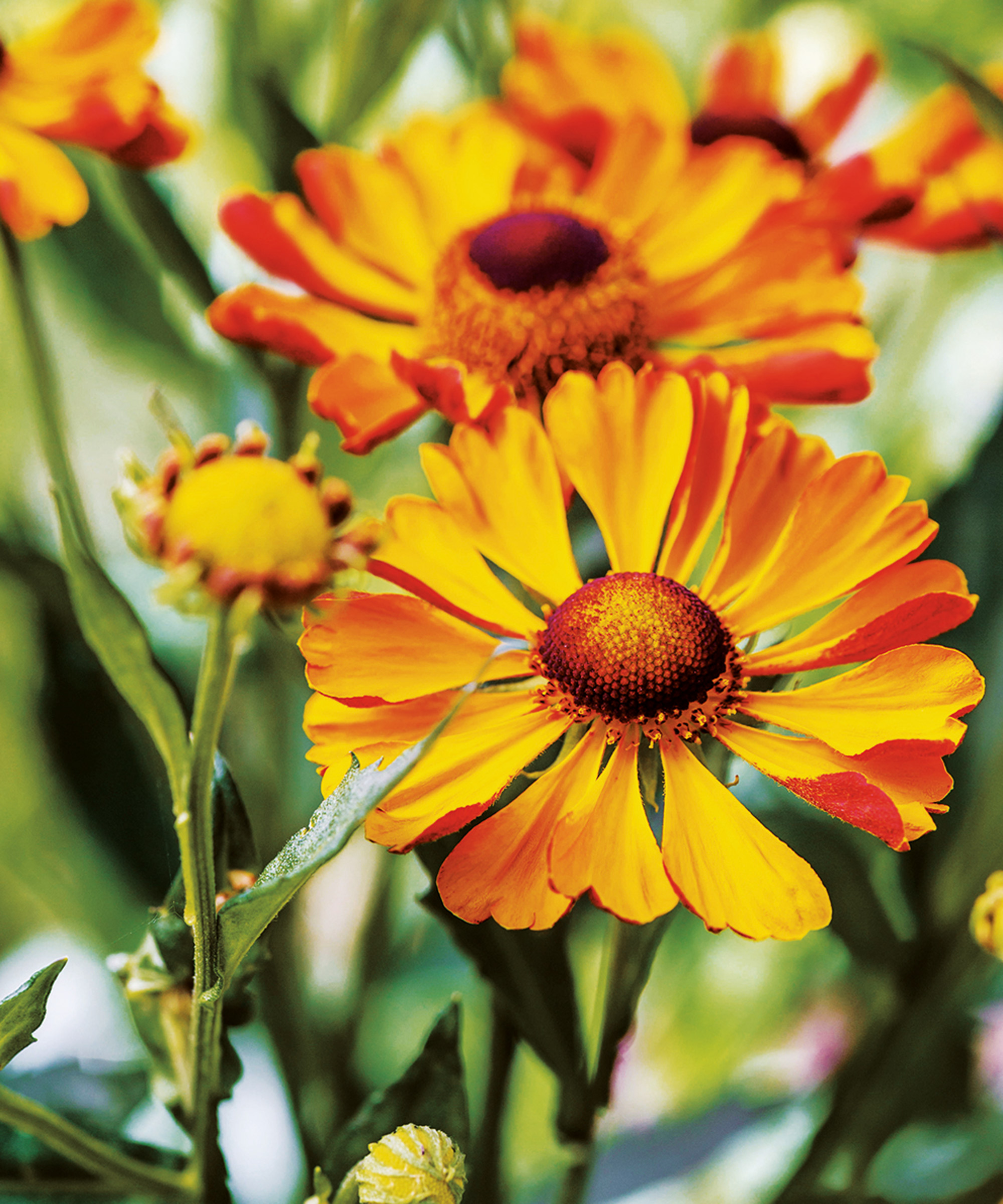
Helenium ‘Rauchtopas’
- Hardiness: USDA 3-8 (UK H7)
- Height: 3-4ft (90-120cm)
- Best for: backs of sunny borders
Two-tone floral lovers will delight in the unusual coloring of ‘Rauchtopas’. Its rich sunshine displays contrast vibrant golden petals on the surface with hot orange undersides. Meanwhile, the central cone or boss starts deep brown and develops into a greeny yellow.
If you are interested in landscaping with grasses, these chameleonic mixed-color beauties give some artistic punctuation to wilder displays. They also give an excellent contrast to softer plantings such as Calamagrostis brachytricha AGM.
10. ‘Double Trouble’
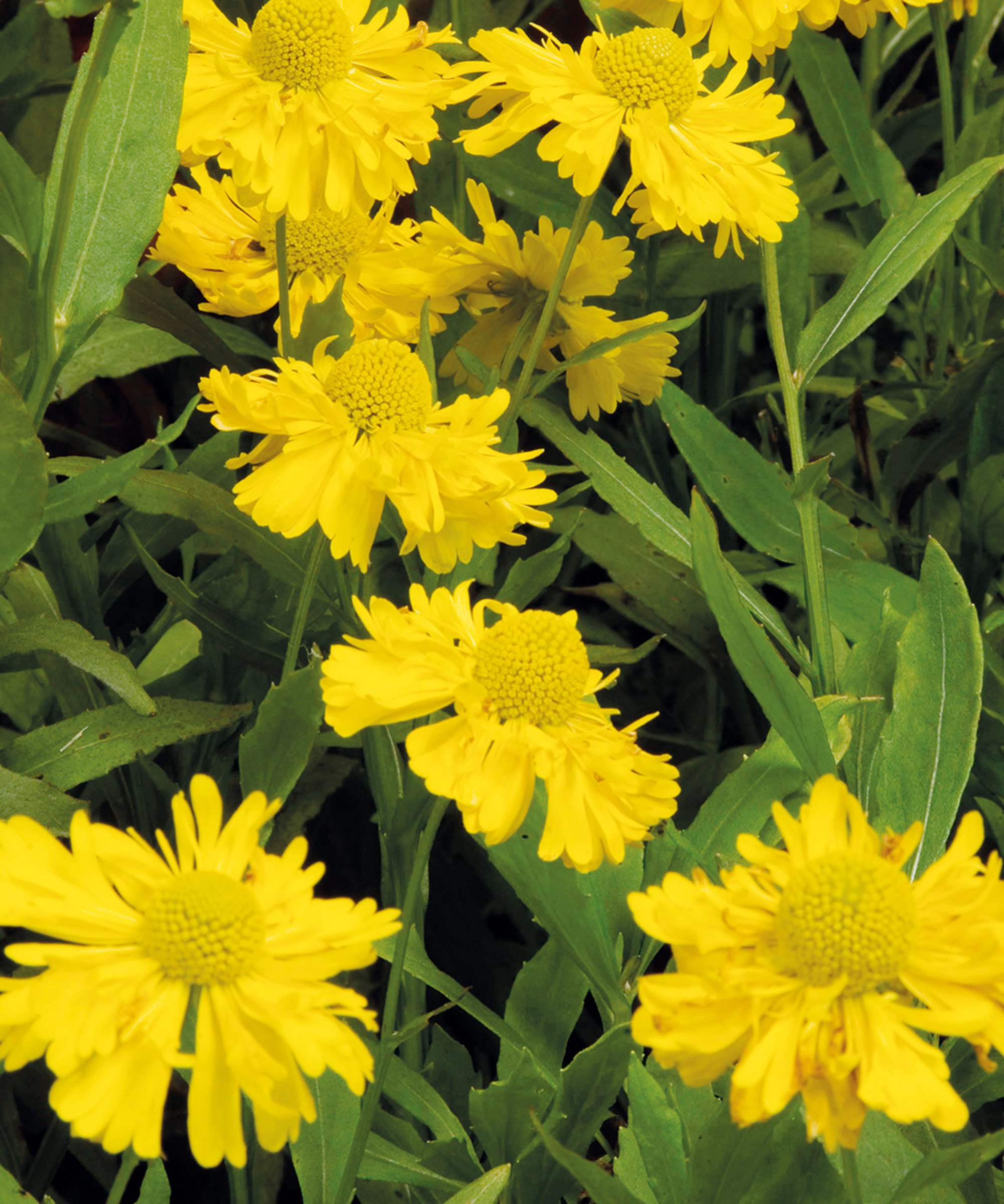
’Double Trouble’
- Hardiness: USDA 3-8 (UK H7)
- Height: 2.5ft (75cm)
- Best for: fluffy ruffled petals
Most types of helenium have a distinct style petal arrangement, but ‘Double Trouble’ is a bit of a departure. This lovely sun-yellow double form develops soft layers of ruffled petals around a gold and lime central boss, making it an excellent choice for cut flowers.
Flowering from late summer into early fall, these golden blooms are lovely offset with pink and purple flowers such as Hemerocallis ‘Lilac Wine’. If you’re looking for vibrant container gardening ideas, these heleniums also thrive planted in well-drained pots of organic compost in full sun.
11. ‘Ruby Tuesday’
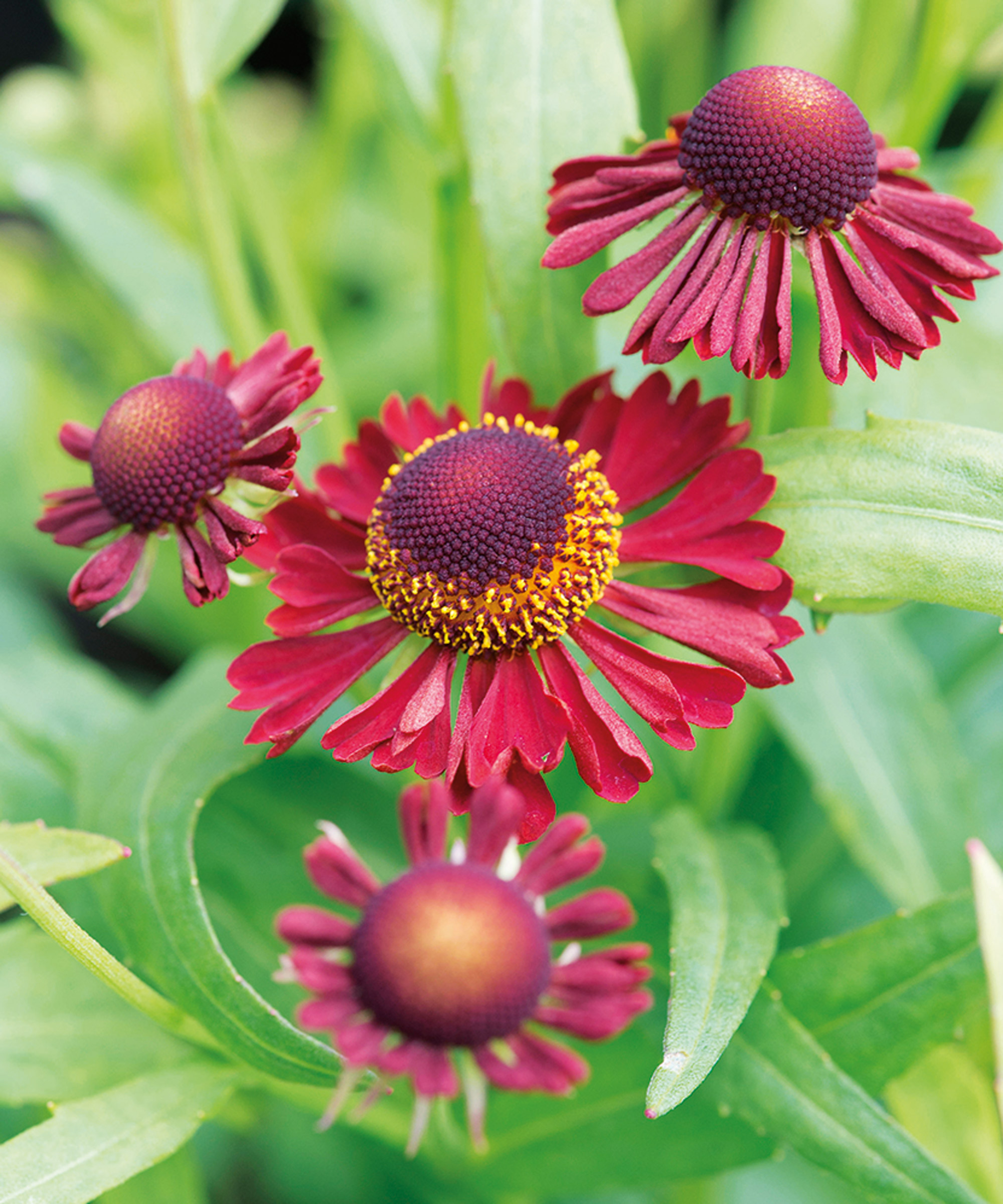
Helenium 'Ruby Tuesday'
- Hardiness: USDA 3-8 (UK H7)
- Height: 2.5ft (75cm)
- Best for: red plantings
With their charming blend of widely spaced crimson petals and relatively compact growth, ‘Ruby Tuesday’ is one of several high-impact heleniums to grow in containers. They work especially well in rustic garden planter ideas and large pots or window boxes.
This shorter red variety, which flowers in late summer and early fall, produces plenty of flowers. Its rich red blooms with their gold edged plum centers also partner well with Anemanthele lessoniana AGM in shimmering border displays.
12. H. autumnale ‘Short and Sassy’
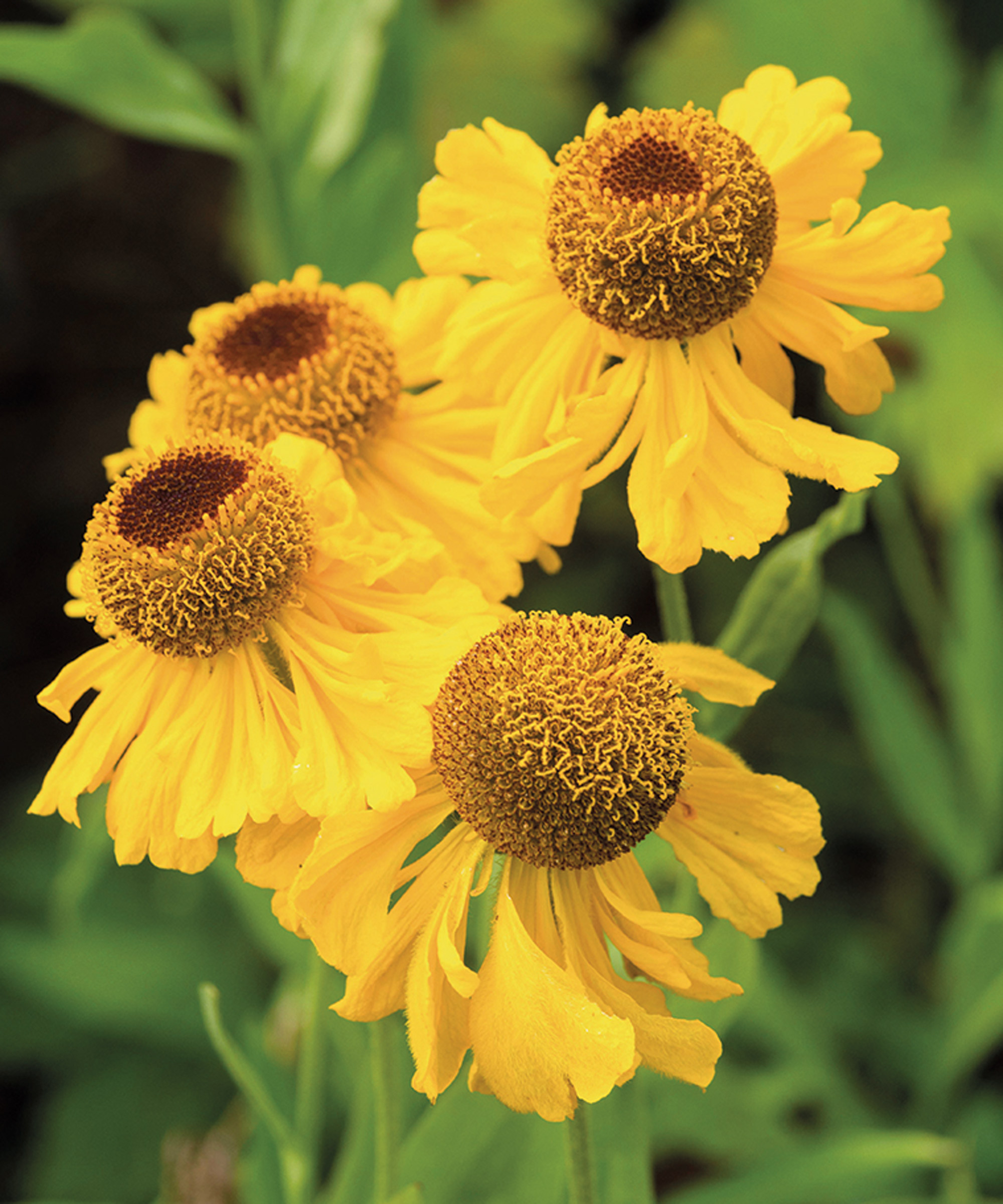
H. autumnale ‘Short and Sassy’
- Hardiness: USDA 3-8 (UK H7)
- Height: 16in (40cm)
- Best for: pots and compact displays
The name of this showy bloomer says it all: H. autumnale ‘Short and Sassy’ is a late-season essential for compact planting. Whether you want a container-friendly helenium to complement the best patio plants or a dramatic addition to a sunny border, this vibrant perennial is ideal.
Like other dwarf heleniums, ‘Short and Sassy’ is a compact perennial that showcases bright gold, amber and orange daisy-like flowers with chocolate-brown centers. Flowering mid summer to early fall, it partners well with purple Salvia nemorosa ‘Caradonna’.
13. ‘El Dorado’
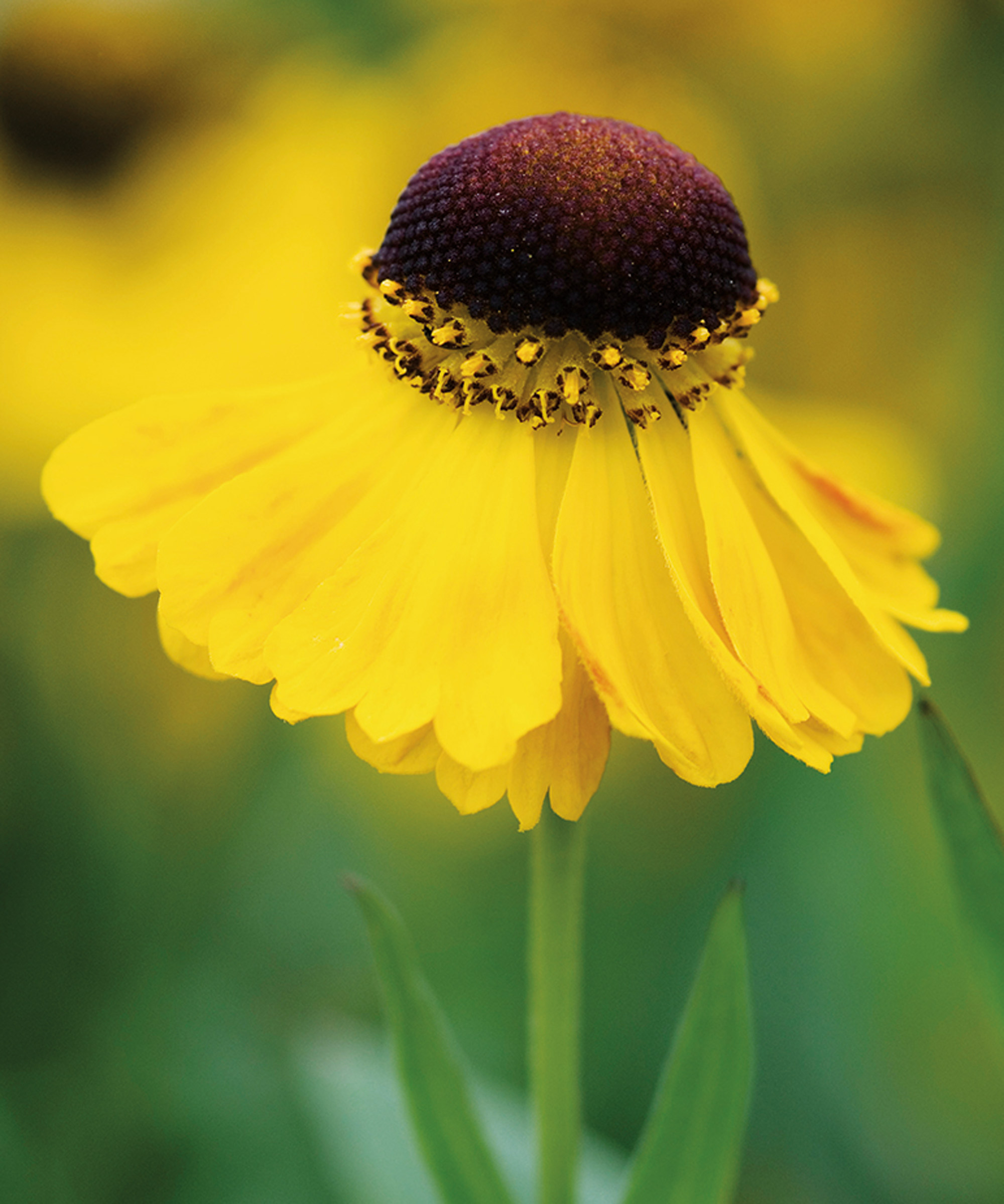
Helenium ‘El Dorado’
- Hardiness: USDA 3-8 (UK H7)
- Height: 2.5ft (75cm)
- Best for: drought tolerance
Lovers of yellow flowers and cheerful sunny displays will adore bright and breezy ‘El Dorado’. This is one of several glorious gold helenium and works well in drifts with sunny grasses like Persicaria ‘Orange Field’ as well as the regal tones of Campanula ‘Sarastro’.
With sturdy stems, generous blooms and an impressively long flowering season, ‘El Dorado is a firm favorite with helenium collectors. Blooming from mid summer until mid fall if deadheaded, it also works well in drought tolerant floral displays.
14. ‘Zimbelstern’
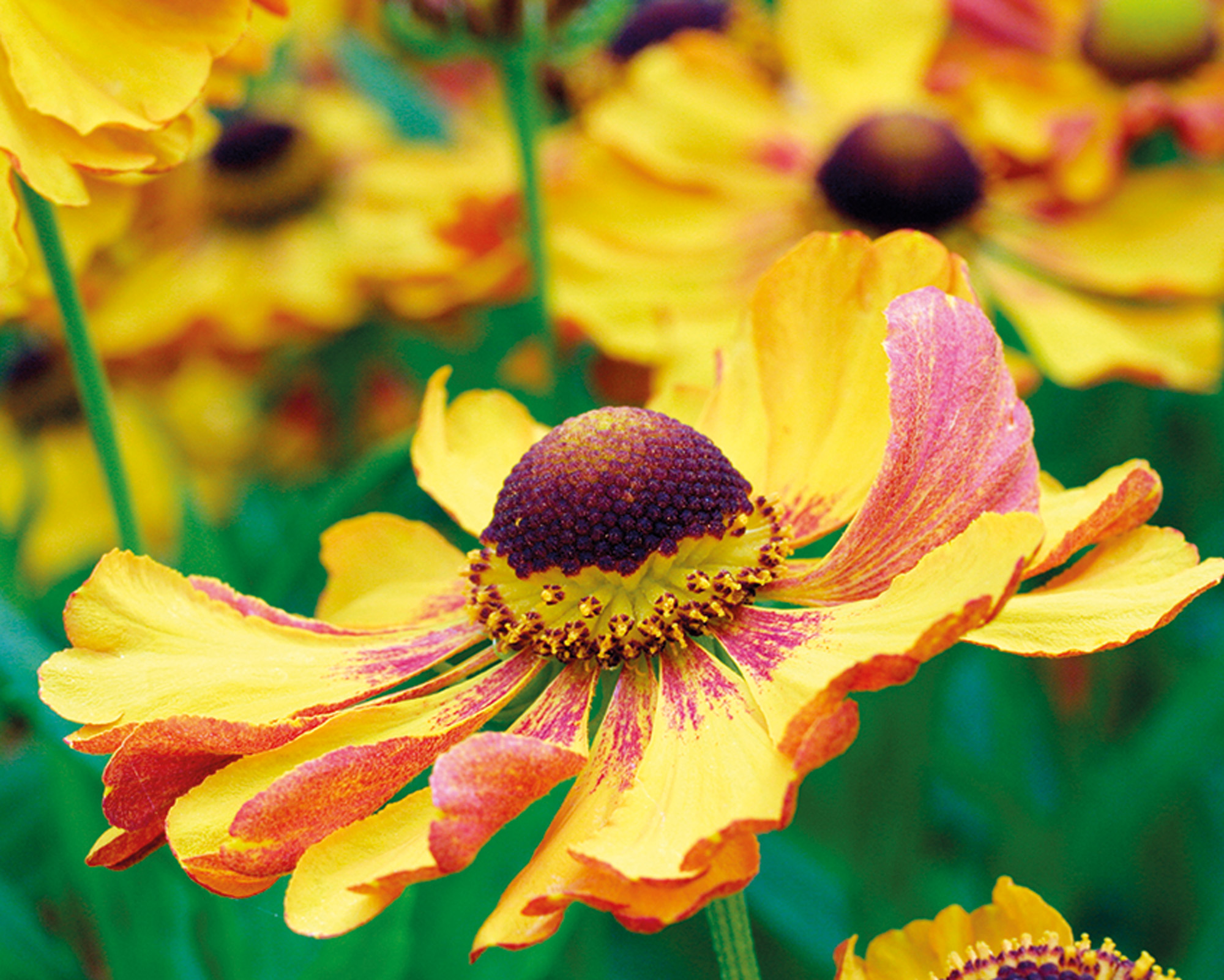
Helenium ‘Zimbelstern’
- Hardiness: USDA 3-8 (UK H7)
- Height: 4-5ft (1.2-1.5m)
- Best for: mildew resistance
‘Zimbelstern’ (aka ‘Cymbal Star’) combines golden flowers with apricot orange splashes and flecks. A fine choice for dramatic south facing garden ideas, this stunner also blooms earlier than a lot of other helenium varieties.
Given its dramatic features, it partners well with drifts of ornamental grasses such as arching Miscanthus sinensis ‘Flamingo'. This helenium grows on robust stems and also has good resistance to mildew.
15. ‘Kugelsonne’
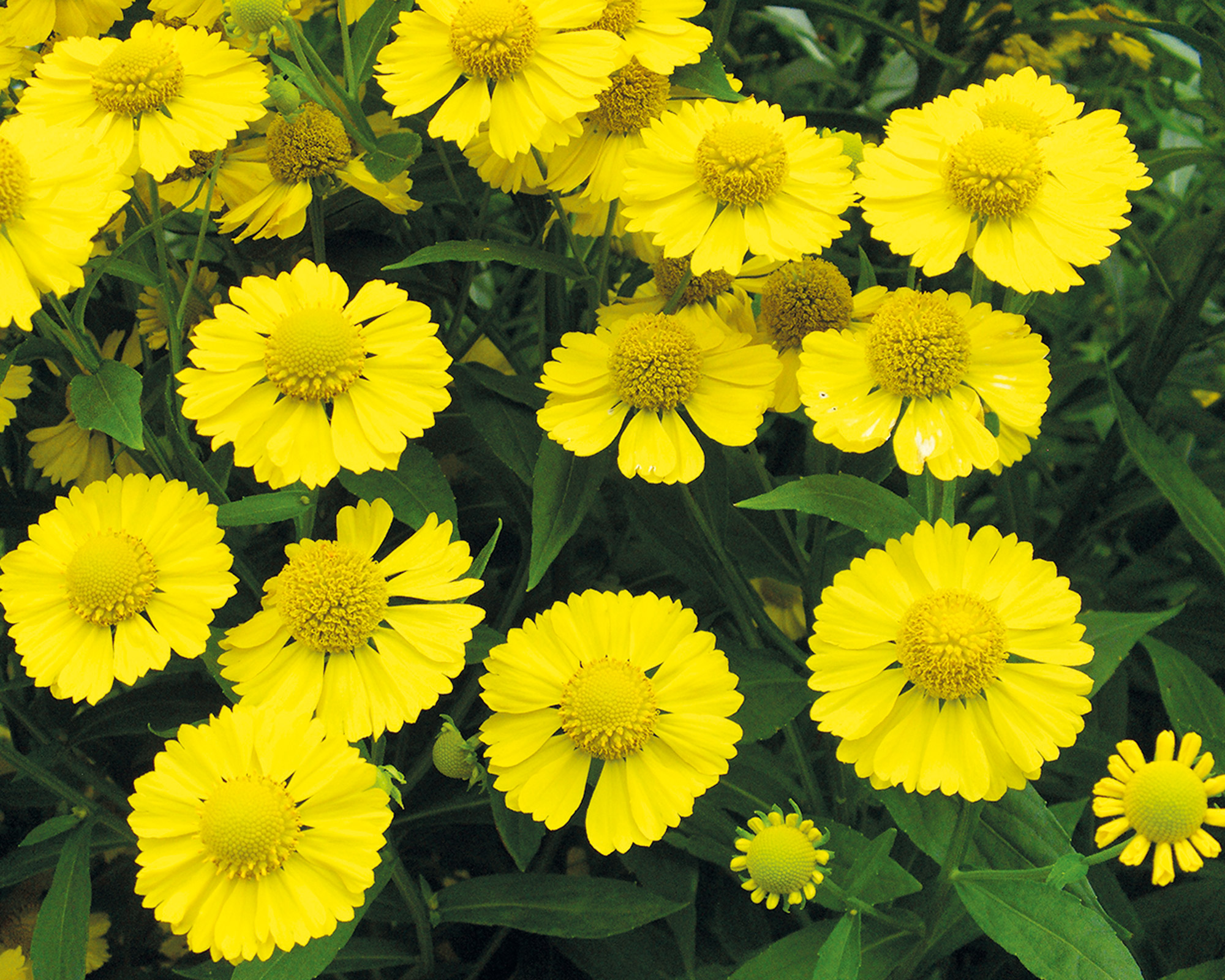
Helenium ‘Kugelsonne’
- Hardiness: USDA 3-8 (UK H7)
- Height: 4-5ft (1.2-1.5m)
- Best for: tall yellow flowers
If you’re looking for a tall yellow bloomer for late summer displays, ‘Kugelsonne’ is one of the most impressive options you can find. Branching stems reach 5ft (1.5m), making this an excellent choice for a cutting garden, prairie-style plantings and backs of borders.
Its name roughly translates as ‘sunball’, and along with dazzling wide petals, it has prominent golden bosses in late summer and early fall. This makes a lovely planting if paired with feathery Molinia caerulea subsp. arundinacea ‘Karl Foerster’.
16. ‘Butterpat’ AGM
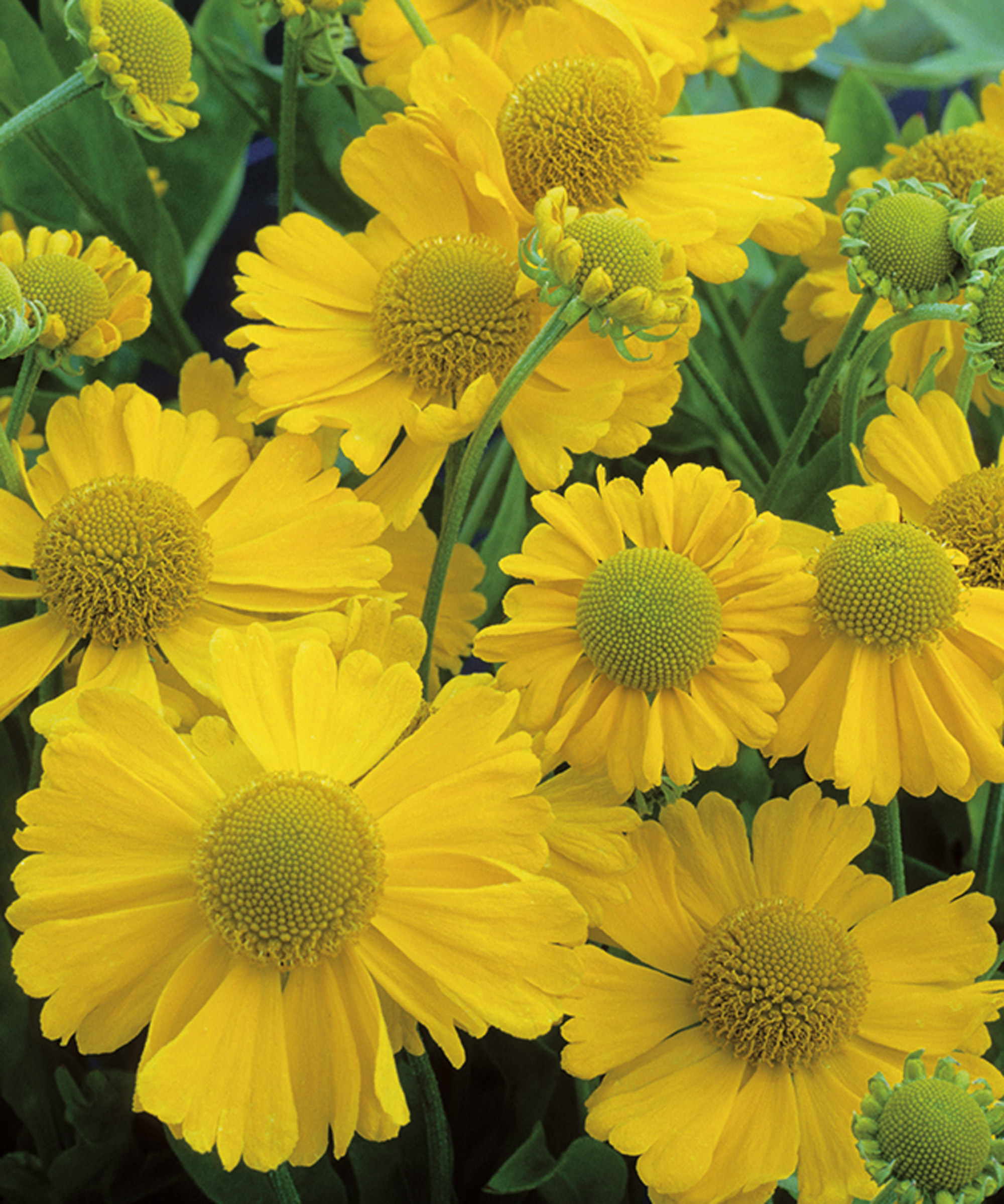
Helenium ‘Butterpat’
- Hardiness: USDA 3-8 (UK H7)
- Height: 2.5-3ft (75-90cm)
- Best for: free-flowering drifts
As the name suggests, this is one of the dynamic yellow varieties with a decidedly warm, buttery glow! With its erect, free-flowering habit, these golden bloomers are great for natural low maintenance flowerbed ideas and prairie drift-style arrangements.
‘Butterpat’ AGM is one of the most widely available helenium varieties with bright yellow florets and a prominent green-gold boss. Flowering from late summer to early fall, its sunny hues partner beautifully with red helenium varieties like ‘Red Army’ as well as Achillea ‘Terracotta’.
What are the tallest types of helenium?
There are quite a few types of helenium that raise their fiery blooms above the pack, making them ideal for the backs and edges of borders. Deep gold ‘Kokarde’ with its lively orange and red streaks can grow up to 4-5ft tall. ‘Indian Summer’ is another of the tallest helenium varieties, with rich coppery reds scaling 4-5ft. And ‘Dark Beauty’ (aka ‘Dunkle Pracht’) also reaches 4ft (1.2m) with its deep crimson blooms.
‘Chipperfield Orange’ and ‘Zimbelstern’ are both capable of scaling 5ft (1.5m) in the right conditions. Unless grown in very sheltered gardens against garden walls, they are likely to need staking. This will prevent your gorgeous flowers from tilting or snapping, and will ensure your blooms are showcased at their best.
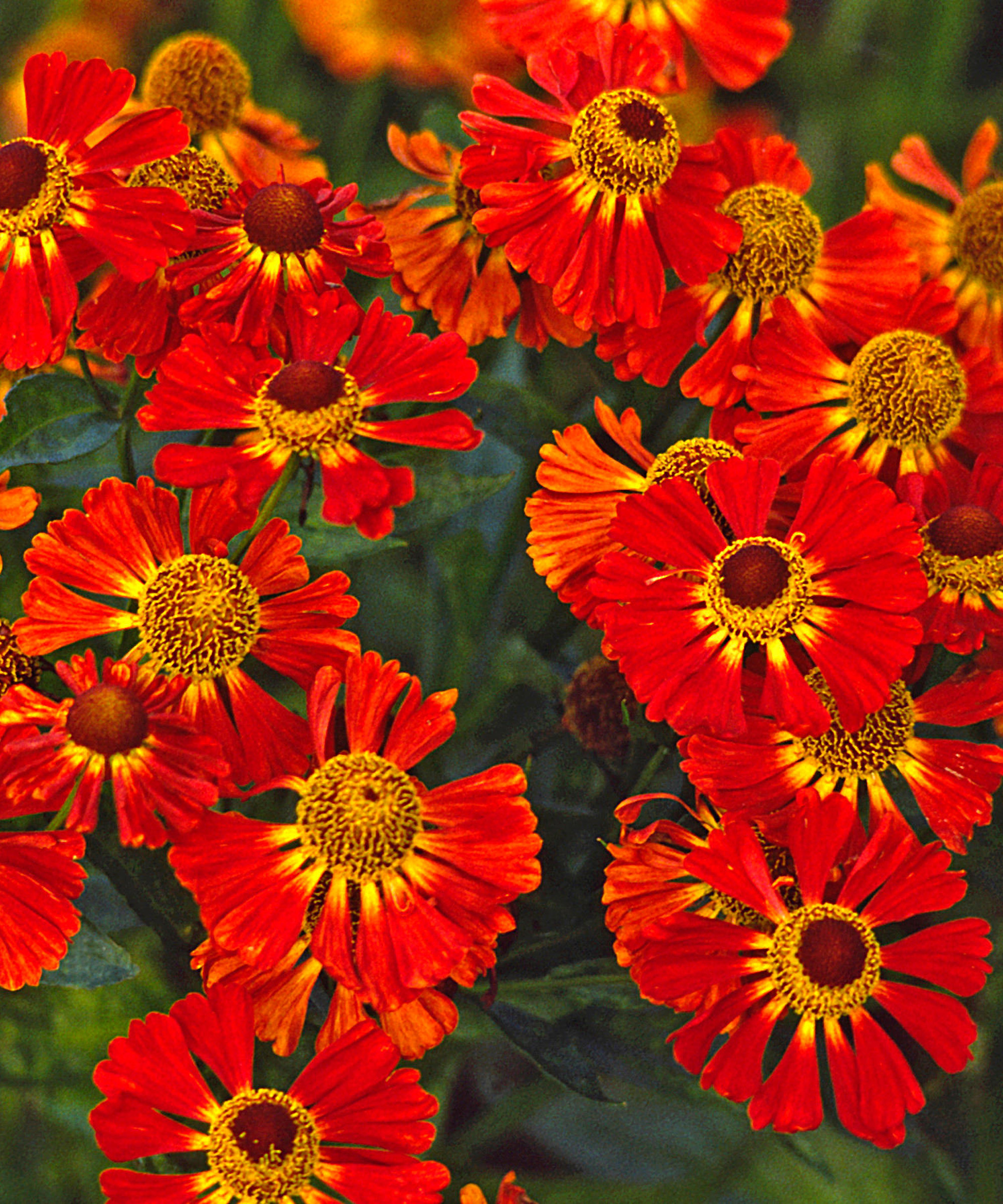
Helenium ‘Dark Beauty’ is a crimson bloomer that reaches 4ft tall
Do all types of helenium need support?
Taller types of helenium will usually require staking, unless they are in a particularly sheltered spot. Even the smaller varieties can benefit from a little bit of support. We’re not saying you need to invest in elaborate trellis ideas or fancy frames, but it’s wise to think about how you can make the most of the upright nature of heleniums and keep them growing in the right direction.
This prevents the heartbreak of them flopping (and potentially being damaged) in wet, windy weather. UK national collection holder David Warden recommends using steel stakes. ‘Order 0.2in (6mm) steel from a local steel supplier and get them cut to 6ft (2m) lengths,' says David. ‘When I get them home, I bend them to shape. They are relatively easy to make – and much cheaper than the bought-in versions.’
Still, not all types of helenium need staking and support. You may find that more compact forms like ‘Lemon Sundae’, ‘Moerheim Beauty’, ‘Short and Sassy’ and ‘Wyndley’ will be fine growing unassisted, either in containers or at the fronts of borders.
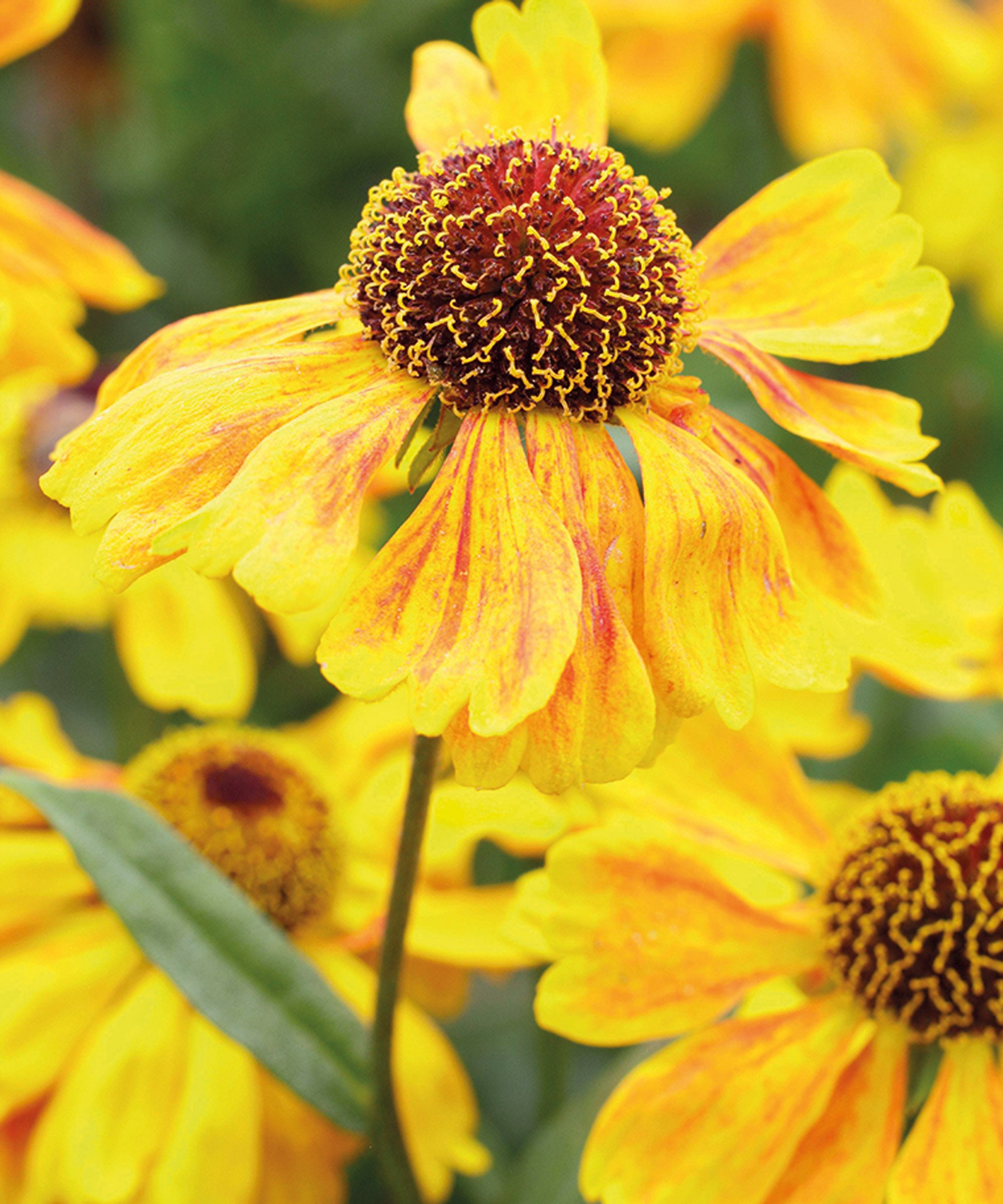
‘Wyndley’ bears masses of yellow flowers yet it is such a compact grower that it does not need supporting
Should I cut back all types of helenium?
It’s a good idea to cut back heleniums at the end of the flowering season. You can also engage in cuts before the flowering season in order to delay flowering if that is your preference. This can also help to control flowering height. While this might sound like a lot to remember, it’s quite easy once you get the hang of it. You have a couple of options in terms of how you do it.
Carry out the ‘Chelsea chop’ by cutting heleniums back in late spring or early summer. This will delay flowering by four to six weeks. Cut back all the stems by a third to a half, if you don’t mind reducing the plant’s eventual height. Alternatively, cut back all stems by a third to a half, around the front of the plant. This will hide any mildew at the back of the plant later in the growing season. Remember to cut with your best secateurs and wear gloves to protect skin from the irritating foliage. Also, bear in mind that deadheading flowers is a good idea to extend the flowering season.
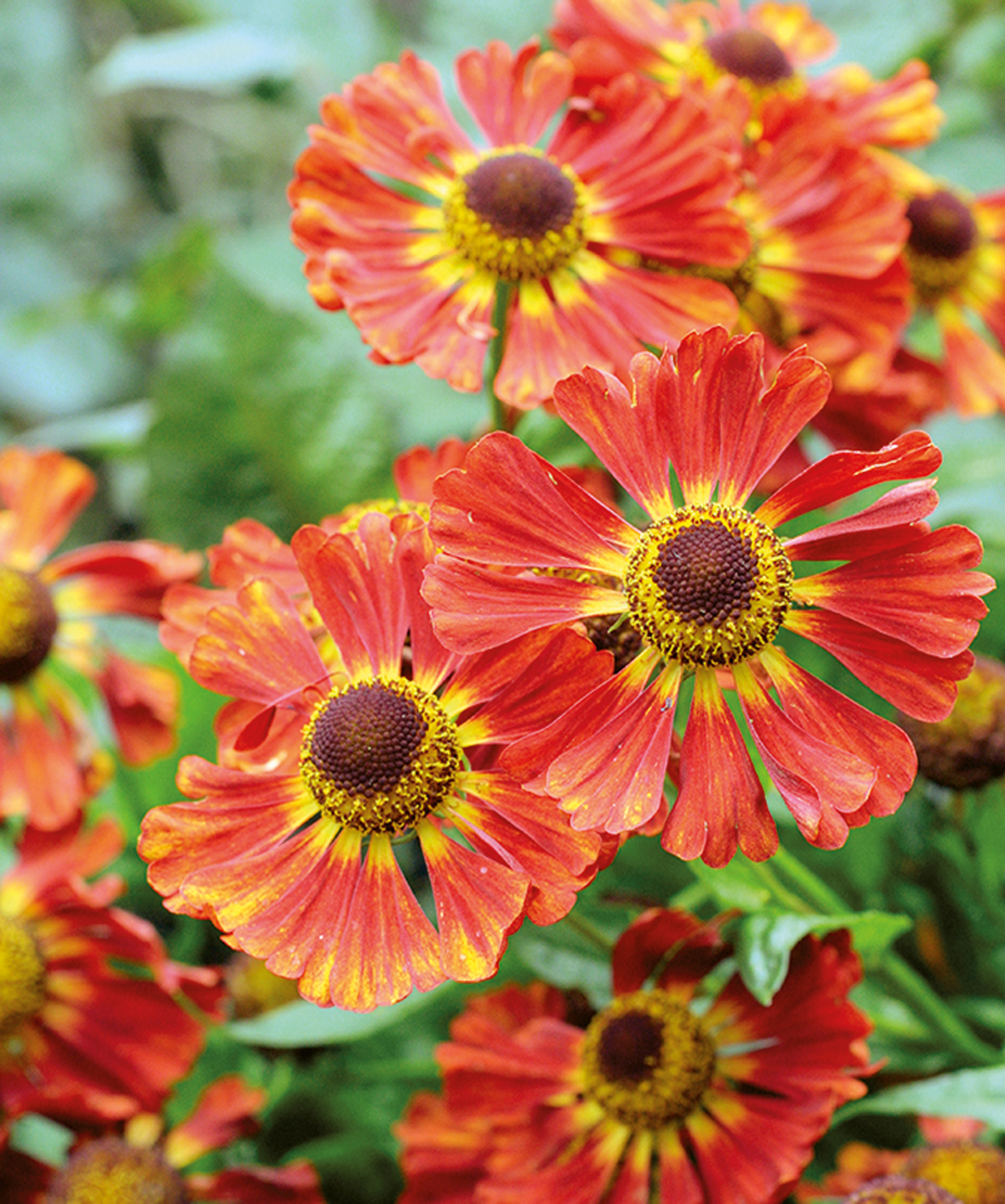
The right cuts can help you control the flowering rate and density of heleniums such as ‘Dunkle Pracht’
Which types of helenium last longest?
Many types of heleniums available for home growing are hardy perennials. This means they will all cope with cool climates. It also means they will live for years, going through an annual cycle of dying back in late fall and regrowing in spring. This is great news for any helenium lovers who get attached to their glowing profusions of color and start pining for them when they die back for winter!
You can help keep different types of helenium in peak flowering health by dividing congested clumps every two-three years, either in spring or autumn. That way, your gorgeous swathes of vibrant fiery color will last even longer and brighten up your pots and borders year after year.
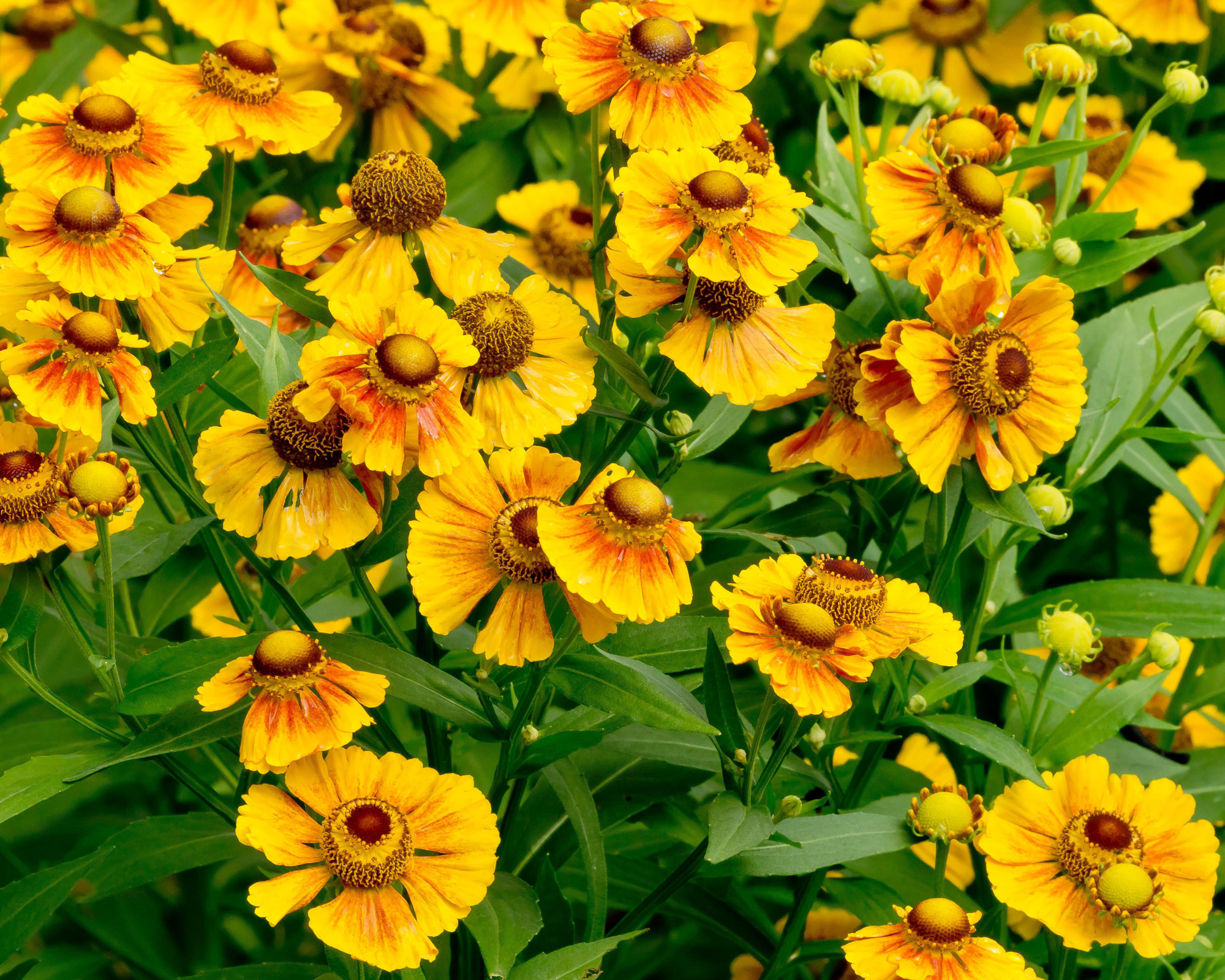
Helenium ‘Kokarde’ is a stunning golden variety that will add lustre to border displays for years to come

As assistant editor of Amateur Gardening magazine, Janey's gardening passion was fostered from an early age, when her amazing mum had her deadheading hydrangeas, mulching roses, and propagating strawberry plants from runners for school open days. She's also taken part in lots of conservation and rewilding projects for the RHS and TCV as a way of exploring her horticultural horizons.
